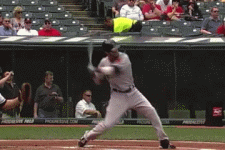
Understanding the First and Second Engines is pretty simple. But syncing them up into a smooth rhythmic unit that creates a seamless one move sudden snap of a swing is where the money is.
How do you do it?
You overlap the engines. You do just as the gears above show. The rearward turn of the Second Engine overlaps the forward turn of the First Engine and it truly feels like gears are engaging at the scap/spine junction.

The last two or three frames of the above clip is the overlap.
Almost every hitter I work with can achieve the proper load with just a bit of work. They get their torsion spring tight at both the top and the bottom. But most will then launch 'out of' the load by pushing the barrel forward as they turn it, instead of launching 'into' the load by unloading rearward.
How to launch is very counter-intuitive. The best thought is to think of getting the barrel to achieve a 'ball on a string' feeling. When you swirl a ball on a string and get it up to speed, it feels like the ball is trying to fly outward out of your hand. Centrifugal force. You must create the same feeling of your barrel and you must create it INSTANTLY. I call this 'Launch and Spend'. Which means you turn it rearward instantly....and you do it 'all in'. You give it all you got instantly and completely to get the barrel into an arc that creates the 'ball on a string' feeling. The barrel speeds around the arc behind your head. It is on auto-pilot so to speak. You do that by launching it, turning it, rearward with your Second Engine. And while all the elements of the Second Engine are important, the forearm rotation is extremely important in getting the barrel to fly rearward around an arc. The weight, direction and the speed of the barrel, when turned rearward, provides tremendous rearward RESISTANCE against the First Engine, as it tries to go/turn forward. When that rearward launched barrel reaches the back of it's arc (gets flat) the resistance goes to zero. No longer is there a strong force moving away from the rear leg. INSTANTLY the leg wins the fight between the two engines and the barrel is yanked forward through the zone with a force that can not be matched by any other technique.

You will know you are doing it correctly when you can confirm that your rear leg is PULLING the resistance of the barrel instead of pushing it. In order for anything to PULL, the resistance must be BEHIND it. When you turn the barrel with great speed, all in, rearward, you are moving the resistance behind the leg so it can PULL. If you do not turn it rearward and instead push forward with your hands and arms, the resistance is beside or in front of the rear leg and it can not pull. It will push.
The scap plays a huge role in a rearward barrel turn. It must clamp down and not move. It's relationship to the spine must not give. The power of the leg gets to the barrel through the scap/spine junction. If you are loose there or if you actively push the scap forward you cause a power leak. The energy you've built up in your First Engine will not reach the barrel. It will bleed. It will dissipate throughout the torso and never reach the barrel. The scap can not move forward. If it does you are launching 'out of' the load instead of 'into' the load. The feeling at the scap/spine junction is similar to bending a piece of plastic between your hands and then releasing one end. The plastic bends then snaps forward when released. Your leg turns your torso and it whips through the scap/spine junction when the scap is held back. This is where the 'gears' engage. This is where the overlap is felt. This is what causes the missing frames.

Slow motion exaggeration of the entire action:
http://hittingillustrated.com/images/ScapPivot.gif
Top of Torsion Spring loaded: Clamping/pinching scap to the spine
http://hittingillustrated.com/images...otPullBack.gif
The overlap: The Twist/Bend of the Torsion Spring.
http://hittingillustrated.com/images/ScapPivotTwist.gif
NOTICE THE REAR HIP PROJECTING FORWARD as the torsion spring is twisted and bent. The leg is turning forward and will PULL from that position.
The release of a well loaded Torsion Spring.
http://hittingillustrated.com/images...votRelease.gif
LISTEN TO HEAR THE WHOOSH SOUND
Where was it?
That deep whoosh will not be there if you don't have the segments that happen so fast you can't see them. Things happen so quickly.
I highly recommend you swing to duplicate the high level pattern. Anyone can verify this information with a bat and a camera and a computer to put your swings side by side with a pro. It is not talent. It is technique. Anyone can do it. And you should if you are teaching.
Can you feel the 'continue on around'....the 'circle'....of Bonds' swing?